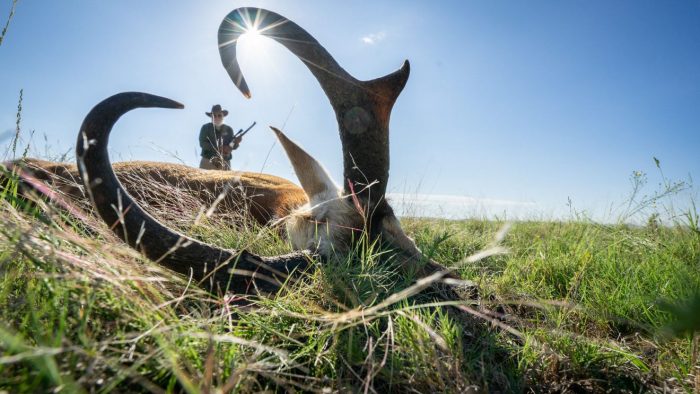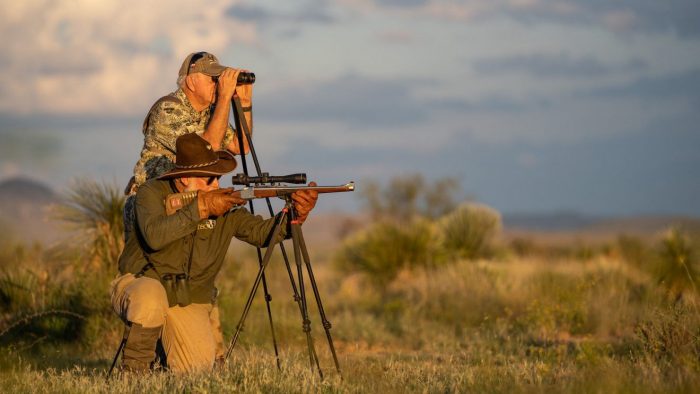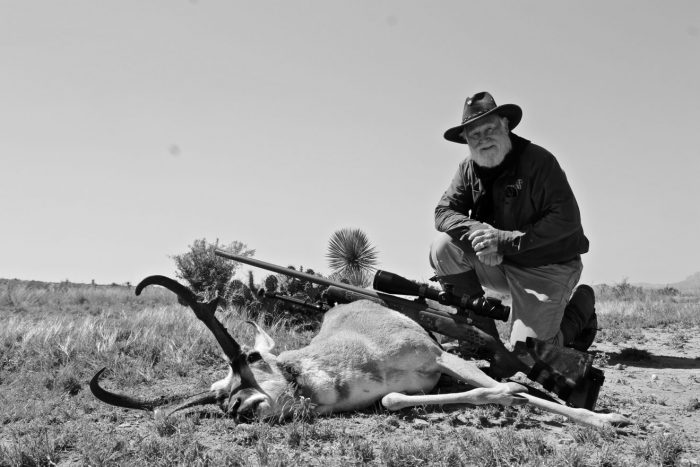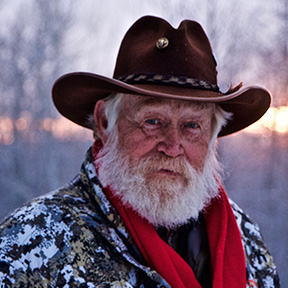Pronghorn Primer II
“Don’t think there’s enough cover to get closer than we are right now. Let’s try it from here.” Bridger and I, essentially hidden behind an outcropping of lava rock, settled in. My young friend removed his silver-belly hat and started waving it just above the jagged-edged rock. “Wouldn’t be doing this if the season were already open, but since we’re three days away from the beginning, it should be OK!” said he. Almost before he finished that statement, the distant pronghorn buck started trotting our way. “Old Indian trick!” said my smiling companion, “They call it flagging. The Kiowa and Comanche used a white-tanned hide.” He continued, “Amazingly curious, aren’t they!”
I continued filming as the 16-inch pronghorn charged in. He stopped merely thirty yards away from where Bridger and I were secreted behind the rock. “Good buck! Think you could hit with that handgun of yours?” Questioned him doing his best to suppress a smile.
I did not “qualify” his question with an answer.
Crawling Close
Four days later, on another part of the northeastern New Mexico ranch, as the first day of the pronghorn season was coming to close, I shot a really nice pronghorn, one we had spent better than two hours stalking, taking advantage of any and every bit of cover. Several times we had made like snakes in the grass, moving only when “our pronghorn” looked away from us. After literally crawling to within less than 100-yards, I rested my handgun on the top of my western hat, settled the gun’s long-eye-relief scope on the buck’s shoulder, cocked the hammer, and squeezed the trigger. At the shot, the buck simply fell forward.
Frankly, I could have taken my shot from a greater distance, but to me, the thrill of the hunt comes in getting as close as possible rather than squeezing the trigger at long range. I had often practiced shooting at distances of 400 yards and knew I could have taken him at that distance with my single-shot .30-06 handgun using Hornady ammo, but that would have only been shooting and to me not hunting. Today with handguns, shooting long-range is possible, but I find pleasure and challenge in trying to get a close as possible before pulling the trigger. The reason I shoot steel at long range is, so I have confidence in my shooting, particularly when I stalk in as close as possible!
While some of you may well have already hunted pronghorn this year, some seasons started in mid-August; my pronghorn hunt this fall will take place in New Mexico, the second weekend of October. In July, at our first annual DSC Foundation Gala, we sold a pronghorn antelope hunt at auction on the Eason Ranch in central New Mexico. The hunt was bought by a great supporter of DSC and the DSC Foundation, who is giving the hunt to his ranch foreman.
With the coming hunt, rather than one of my handguns, I will be using a Remington Model 700, .280 Remington, topped with a Trijicon Tenmile HX3-18×50 scope and shooting Hornady’s 150-grain ELD-X Precision Hunter ammo. It will be filmed by Safari Classics, who produces “Trijicon’s World of Sports Afield,” sponsored by Remington.
My last two pronghorns, hunting with Greg Simons’ Wildlife Systems, I used two different rifles. Both were topped with Trijicon AccuPoint scopes and appropriate Hornady ammo. On that first antelope hunt with Greg, I used my Ruger No. 1 RSI chambered in .257 Roberts. Longtime friend Don Richards was my guide. After passing numerous bucks, some of which I suspected were a bit over 16-inches in length, we found a buck with long and then deeply curving inward, lyre-shaped horns. After several attempts to get closer, I finally decided to take a shot, albeit and appropriately for that round, 257 yards.
My buck turned out to have the longest horns to date of the numerous pronghorn I have taken. Both sides were 17 ½-inches long, with good mass and relatively long prongs. To say he was handsome and magnificent would be an understatement.
On the second hunt, I used Dave Fulson’s custom Remington Model 700 chambered in 7 mm Rem Mag, topped with a Trijicon AccuPoint and shooting Hornady’s 162-grain ELD-X Precision Hunter. After passing up numerous bucks, guide Ted Simpson I found one with outward flaring prongs which looked really good. Having sprayed down with TRHP Outdoor’s Scent Guardian, which earlier had allowed me to walk in the broad open from 600 yards to a mere 13 steps of a mature buck, I stopped at about 75 yards, got a solid rest, and shot the mature buck.
With those two hunts freshly on my mind, I’ll be heading toward the Eason Ranch in central New Mexico. As mentioned, I’ll be using my .280 Remington on this hunt. I have it sighted in at 100 yards but will dial-up to my “Hunter Zero,” which puts me dead on at 200-yards and 8-inches low at 300. Thus, I will “own” any shot out to 300 yards without having to dial-up. And that is my intention, to get within 300 yards or less. However, thanks to having spent time on the FTW Ranch and their Sportsman All-Weather, All-Terrain Marksmanship Hunter Training, Tim Fallow “built” a range card for my .280 Remington, 150-grain ELD-X, and Trijicon Tenmile scope combination, so if it comes down to it and I have to take a longer range shot, I’ll know exactly how far to dial-up and to hold of the appropriate wind. The only reason I would consider shooting beyond 300 is if we find one of the two monstrous bucks the rancher has seen recently, and there simply is no way to get closer.
Having in the past shot quite a few pronghorns, on this hunt I will be looking for an exceptional buck for starters, but I also like to eat pronghorn! That said, pronghorn horns can be difficult to judge. I will be looking for a buck that is beyond 15-inches in length on both sides, with good mass and good prongs. That means I will be using the average frontal part of the eye to nose measurement on most pronghorn to compare to horn length, or 8-inches. Too, I will be comparing ear length to horn length, ears from their base to the tip usually measure 7-inches. To get an idea as to mass and prong length, I will compare these two to the average width of a pronghorn’s ear, which is 2-inches.
Some pronghorns have fairly straight horns, while other have tips that curve forward, inward or backwards. The deeper the curve of lyre shaped horns, the longer the length. Some pronghorn bucks have horns (true horns, and the only antelope species that has pronged horns and horns which are annually shed and regrown) with translucent tips. These, although possibly not immediately noticed, can add an inch or two to your length estimation.
Optics, meaning in this instance a good spotting scope of say 20x and binos of 10x, will be my constant companion. My spotting scope goes well beyond 20x, but usually on the plains, where mirage can be tremendous, usually suffices. Much beyond 20x mirage will greatly distort what you are looking at.
If you have not hunted pronghorn antelope in the past, may I suggest you do so. Pronghorn are our true plains hunt in North America, and too, they are a tremendously successful conservation story where hunters’ dollar brought them from the edge of extinction to truly healthy and sustainable populations.
Once I have taken the hunt I will let you know how we did. You too, will be able to see our hunt on an upcoming episode of “Trijicon’s World of Sports Afield”. And, I will also tell the story on one of my weekly podcast episodes found at DSC Campfires.
Professional wildlife biologist/outdoor communicator, Larry Weishuhn, known to many as “Mr. Whitetail”, has established quality wildlife management programs on over 12,000,000 acres throughout North American and other parts of the world. He has hunted big game with rifle and/or handgun on six continents. Larry is a Professional Member of the Boone & Crockett Club, life-member of numerous wildlife conservation organizations including the Dallas Safari Club, Mule Deer Foundation, and Wild Sheep Foundation. He currently serves on the DSC Foundation Board of Directors, is one of three co-founders of the Texas Wildlife Association; is a member of the Legends of the Outdoors Hall of Fame and the Muy Grande Hall of Fame; he too, received the Zeiss Lifetime Achievement Award among many other honors.




